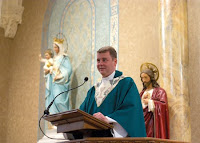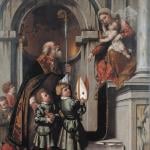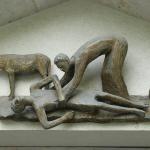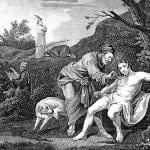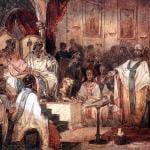 It’s time for me to write about this blog and how it started and how it has continued. I have written on two previous occasions about “minor miracles,” one involving my father’s final days and one involving my beloved bride. (There are several more Katie mm’s I could recount, and I probably will before my blogging days are done.)
It’s time for me to write about this blog and how it started and how it has continued. I have written on two previous occasions about “minor miracles,” one involving my father’s final days and one involving my beloved bride. (There are several more Katie mm’s I could recount, and I probably will before my blogging days are done.)
I was goaded into this post by Mary P., whose second comment on my St. Paul post of yesterday was too provocative to pass up.
In her first comment Mary began with St. Paul: It’s not like he got a book of instructions. . . . How do those of us waiting for that lightning strike figure out if something is God’s will? I’ve taken it to mean if you’re drawn to something, such as a particular action, but that action looks really challenging, but you can’t seem to get it off your mind, then God is probably calling you to do it. If you’re wrong, then God will make it pretty clear.
In her second comment Mary wrote about this blog: You thought or heard or dreamed or SOMETHING and that started it. Your intention was different than what it is now. That doesn’t mean you didn’t or aren’t doing what God wanted/wants you to do, just because you thought you were doing it for another reason! Am I right that you hesitated when you realize the blog was morphing? Please understand I’m not picking on you, but you are the obvious example. The blog grew, and you began to see that it was having an effect on people that you never conceived when you started. Then Frank came onboard (did you think that was an accident? Not me!), and look at it now!
So, the bolt of lightning . . . or maybe . . .
Chapter 1 — The Breeze
I was in Maine with Katie in August, pretty much as you see me in the picture at the top of this post, a picture Katie took from her kayak. Yeah—relaxed, happy, open.
I had been thinking about starting a blog for my memoirs business. No techie myself, I had heard from a friend how easy it is to start a blog. So one day I logged on to Blogger.com and started Memoirs Unlimited, the blog. Clickers will find that there are all of 5 posts at that site, versus 280-some-odd posts and counting at YIM Catholic. Does that tell you something?
Back in the spring, I had been in touch with an old college friend, who I wrote about here. He’s #5 and #13 on the list. My friend asked me why I had converted and I had no ready answer. But being a writer I promised him I would write him some short essays about my conversion experience. Which I did, for his eyes only.
Two posts into my Memoirs Unlimited blog, the lightning bolt hit, although it was more like a gentle breeze from the open window of the bedroom where I set up my writing shop when we are in Maine. The breeze said, “That’s not what you want to do. You want to write about your conversion experience. And you’ve already written the first three posts, including one about the book that started it all, by Fr. James Martin.”
Now, here’s the beauty part. That thought made me pretty happy, so I logged onto Blogger and hit the start-new-blog button. As before, with Memoirs Unlimited, Blogger asked me what I wanted to name my blog, which would establish the unique URL. I stared at the screen, then typed: Catholic Convert. Blogger informed me that Catholic Convert was already taken, dummy. I typed something else equally generic, like New Catholic. That was already taken too, stupid. I typed two or three more ideas, was rejected each time, then stopped for a moment: What do I want to write about? I want to write about why I am a Catholic. . . . Well, obviously we have to come up with something oddball to beat this overloaded system. Then I thought: Acronym. Or maybe it was: Rebus. Or maybe there was no thought at all. I typed: YIMCatholic. Blogger dinged at me: Congratulations! You have a blog! Begin entering content!
Within minutes, the consequences of this chain of events hit me: If the title is “Why I Am Catholic,” every post will have to be an answer of sorts. That hit me like inspiration. Not my inspiration, I can promise you that. I did not think through the consequences before choosing the blog title. The consequences were there.
Chapter 2 —The Lightning Bolt
That was August 17, 2009. Over the first ten days, I posted eight times, including three of the essays I had written for my friend. I was very happy, almost giddy, writing some of these posts, but I thought I was running dry. Then, on the evening of the tenth day, while back home in Massachusetts for some business meetings, I received this e-mail:
Dear Mr. Bull,
Many thanks for your beautiful post,
which a friend passed along to me.
I’m delighted that my book helped
you so much, and so happy that the saints
have been your patrons and companions
in your journey into the church.
Welcome!
Jim Martin, SJ
I was flabbergasted. I had no idea anyone was even reading YIM Catholic. Honestly, I had next to no ambition about it, except to send each post to Katie, our daughters, Father Barnes, and three friends in the parish, Ferde, Carol, and Ellen. I thought that was my readership, give or take a lonely late-night Web surfer in Altoona.
If there was any lightning bolt in this story, that was it, the e-mail from Fr. Jim in New York. I called Katie in Maine the following morning and gasped. She gasped back.
Chapter 3 — The Ego Trip
Chapter 4 — The Crisis of Faith
Chapter 5 — The Crazy Marine from the Old South Who May Be An Angel Or Something
Chapter 6 — Building a Community
To be continued . . .







